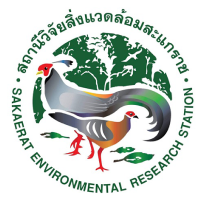Keywords :
Biomass; Primary Production; System Transfer Function; Energy Flow
บทคัดย่อ :
The aboveground and belowground biomass of Arundinaria pusilla in two strata of the dry
dipterocarp forest were monthly harvested and net primary production, accumulation and disappearance
rates by compartment were estimated. These data were further utilized for determination of system transfer
functions and the efficiency of energy capture. The results indicated that the aboveground standing crop
of standing live, standing dead and litter varied considerably through different sampling intervals within
and between each stratum. More belowground biomass was concentrated in the upper soil layer and the
amount declined with an increase in depth. The community annual aboveground net primary production
was estimated on ash-free basis to be 210 gm-2 on stratum 1 and 329 gm-2 on stratum 2 and the belowground
net production was 2,844 gm-2 on stratum 1 and 2,884 gm-2 on stratum 2. The accumulation of standing
dead (256 gm-2) and litter (214 gm-2) on stratum 1 was greater than the standing dead (198 gm-2) and litter
(137 gm-2) on stratum 2. Annual disappearance of litter was also higher on stratum 1 (149 gm-2) than that
of stratum 2 (119 gm-2). But the belowground disappearance was much greater on stratum 2 (2,794
gm-2) than that of stratum 1 (2,573 gm-2). Annual efficiency of energy capture was estimated to be 1.77
percent on stratum 2 and 1.86 percent on stratum 1based on 50 percent usable solar insolation. It was shown
that the belowground portion of Arundinaria pusilla played an important role in the dynamics of the system
as a whole. This study confirmed that the belowground biomass in this kind of plant community should
be considered as being very important in the study of the ecosystem functions.
เอกสารอ้างอิง :
Ruangpanit, N. (2000). Primary productivity of the Pygmy bamboo (Arundinaria pusilla) in the dry dipterocarp forest at Sakaerat, Nakhon Ratchasima. Agriculture and Natural Resources, 34(1), 125-138.



